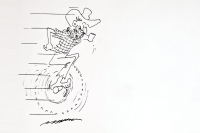WCU campus Master Plan wins approval of Board of Trustees
A new campus Master Plan endorsed Friday (Dec. 6) by the Western Carolina University Board of Trustees is designed to closely link physical facilities of the university, including future construction and renovation, to goals of its recently approved strategic plan.
The Master Plan is meant to provide “a flexible framework for growth,” said Keith Storms of Hanbury, Evans, Wright and Vlattas, a firm specializing in campus design and planning.
The plan is based on enrollment projections that anticipate more than 11,000 students studying on the campus in Cullowhee by the year 2023, and the need for approximately 486,000 gross square feet of additional interior space to accommodate the needs of those students. Currently, about 7,800 students out of WCU’s total enrollment of 10,107 live and study in Cullowhee.
Approval of the plan, which was drafted with the guidance of a 16-member task force, comes after a 17-month process that included numerous public forums designed to collect input and feedback from university students, faculty and staff and from residents of surrounding communities.
During that process, the task force and the master plan consultants presented numerous options for land use and future development. Feedback from the campus and community led to a preferred land use plan that focuses on reinforcement of the existing academic core of campus, reconnects that core to the historic hill area of WCU and seeks opportunities for strategic development around the new Health and Human Sciences Building on the university’s West Campus.
Related Items
In presenting the Master Plan to the board for its consideration, Chancellor David O. Belcher called it “a living document, one that is not set in stone but will be a guide to us as we go forward.”
Highlights of the plan, which attempts to take advantage of natural synergies among academic programs without creating “academic silos,” include:
• Construction of a new science building of approximately 130,000 square feet that would replace the existing Natural Sciences Building and create a “science quad” by incorporating renovations to the existing Stillwell Building.
• Construction of a new building for the College of Business and additions to the existing Forsyth Building, which is home to most business programs.
• Consolidation of programs in the College of Fine and Performing Arts to new and existing space near the John W. Bardo Fine and Performing Arts Center.
• Enhancing pedestrian connectivity across campus, especially between the academic center of campus and the historic area. The plan envisions a signature building located between the upper and lower areas of campus that would house existing programs in student engagement and related activities.
• Additional revitalization of the historic hill area of campus, including improvements in transportation flow and new residence hall and dining space for 300 additional students.
• Creation of a new main entrance to campus on N.C. 107 that links the traditional campus with the newer West Campus, with a new visitor center and enhanced public parking for visitors attending fine arts, athletics and entertainment events at the Bardo Arts Center, Ramsey Regional Activity Center and athletics fields.
• Phased development of two buildings for private/public partnerships adjacent to the Health and Human Sciences Building on the West Campus while reserving steeply sloped land as an environmental preserve.
• Enhancing views of and recreational opportunities along Cullowhee Creek as it flows through campus by removing invasive vegetation, and using existing green space in the floodplain of the creek for recreation and athletics fields.
• Improvements to athletics facilities including a new field house, indoor practice facility and enhanced stands and a new press box on the west side of E.J. Whitmire Stadium.
• A possible mixed-use facility featuring dining and retail space on the ground floor and residential space on upper levels.
During an afternoon of open discussions and committee meetings on Thursday (Dec. 5) prior to the board meeting, some members of the board asked what impact a Nov. 21 fire that damaged three businesses in the commercial strip in the center of campus might have on projects proposed in the Master Plan.
University officials say they are unable to speculate on the future of the site at this point. The university received a report late last week from the State Construction Office on the structural integrity of the building, and are awaiting a cost estimate for repair or replacement of the building from architects hired by the university, as required by the N.C. Department of Insurance.
Additional information about WCU’s master planning process can be found at the website masterplanning.wcu.edu. Additional information and updates about the fire can be found at the website fire.wcu.edu.









